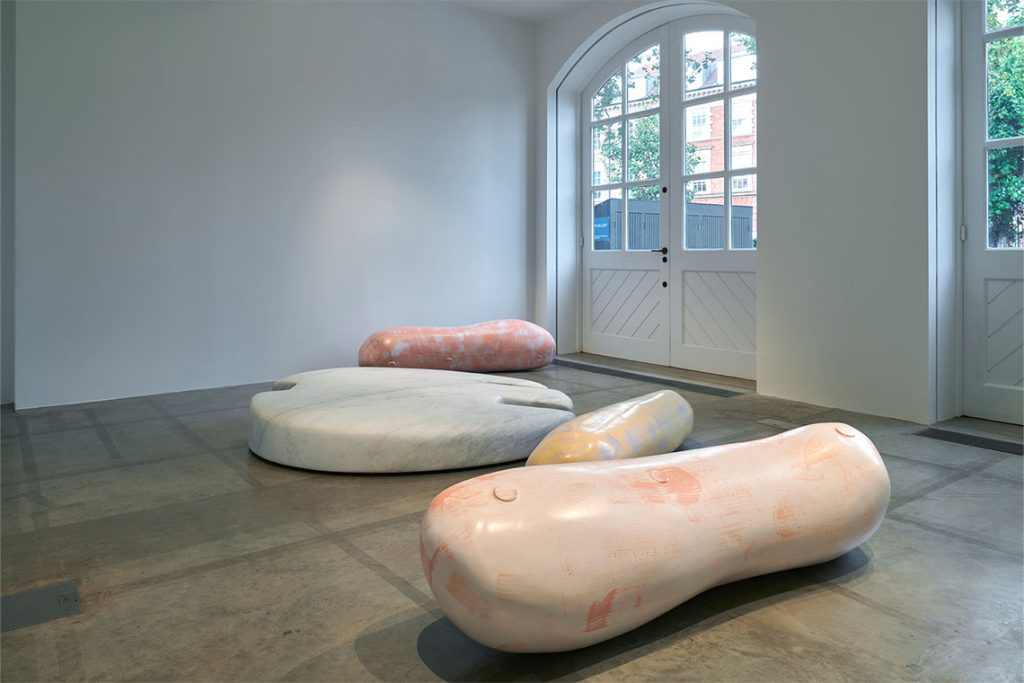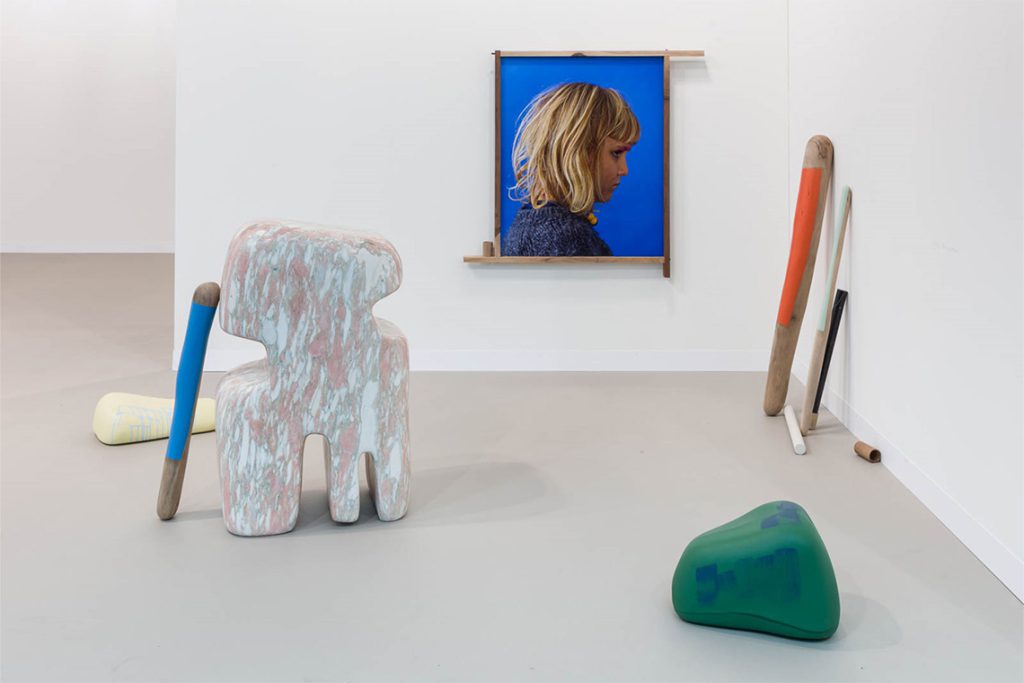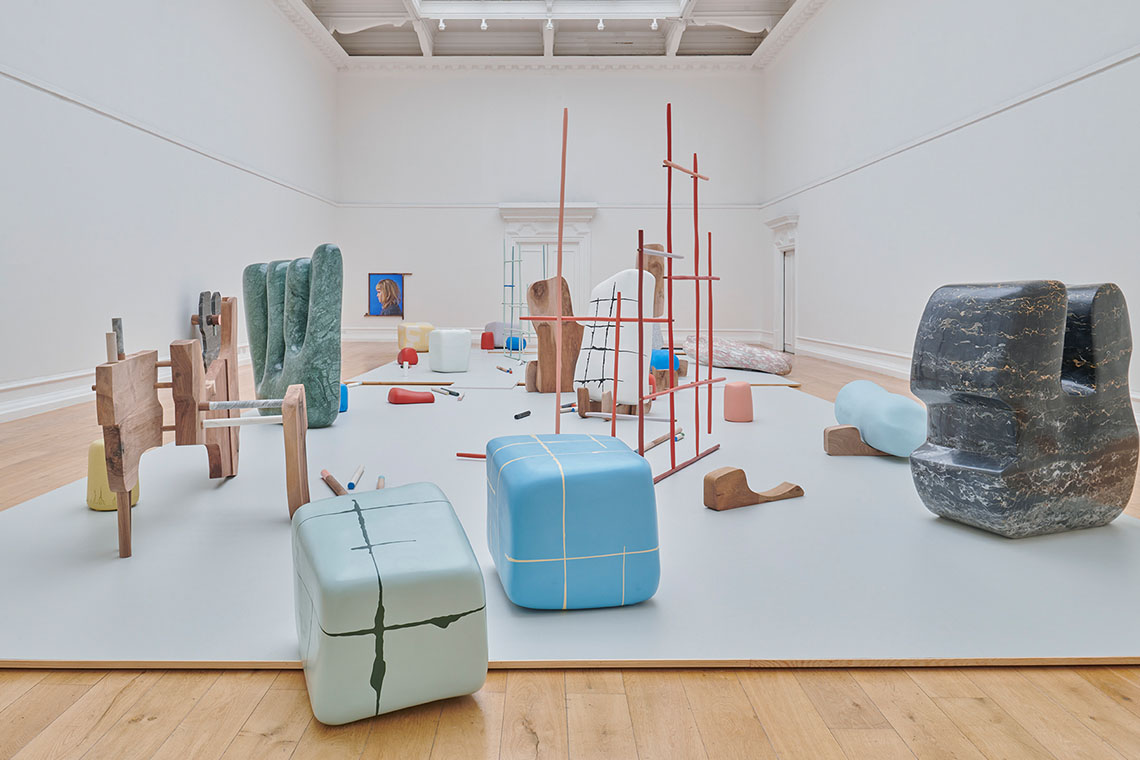In her latest solo show, Jumbled Alphabet at South London Gallery, Nairy Baghramian aims to reveal both the fun and necessity of visual disordering.
Exhibitions at Peckham’s South London Gallery (SLG) are typically ranged across its two locations: the Main Gallery and the nearby Fire Station building, about a two-minute walk down the street. So it is for Iranian-born, Berlin-based Nairy Baghramian’s current solo exhibition, Jumbled Alphabet. Baghramian is a renowned sculptor who has participated twice in the Venice Biennale (2011 and 2019), as well as in Documenta and other major international exhibitions. Her practice is conceptual yet theoretically and politically minded; she looks at the relationships between architecture, design and the body, pulling them apart in an almost Derrida-esque way to see how they might be unravelled, questioned, tinkered with.
As a title, Jumbled Alphabet already implies the upsetting of an established order. In SLG’s Main Gallery, a large, airy, well-lit hall space, an enormous assortment of large and quirky sculpted objects is littered across the floor, placed both on and off low-level plinths. Red laddered pieces recall jungle gyms from the playground. Colourful sticks lying underneath resemble gigantic crayons seen from afar. A marbled dark-green structure looks both like a big gloved hand with fingers and a shiny, oversized cactus. Here and there, pastel-coloured cubes and cylinders, appearing stretched, softened or even pulled like dough, beg to be sat on; from a distance, they could be comfy, tufted chairs in a children’s classroom. Yet upon closer glance, their smooth, rigid hardness betrays this illusion.

Image courtesy of the artist and South London Gallery
The installation is constructed from these many little subversions. Baghramian has taken the sculptures from an ongoing series aptly named Misfits, wherein – inspired by children’s building toys – she aims to celebrate the beauty of the ‘dis-functional’ by disrupting the idea of things fitting together perfectly for a wider, purposeful whole. In the Main Gallery, the various pieces’ materials – often evoking plants, Play-Doh, flesh, clay or cake, don’t just play optical illusions via form and material but also through curation. All the sculptural pieces are on a low-level platform, altering how sculpture is normally interacted with when exhibited, that is, reified upon higher pedestals or plinths. Some of them are not contained on the platform, instead spilling or toppling off it. Baghramian literally redirects our gaze, bringing it down to the level of a child engrossed with an overflowing toy box.
The Misfits series was initially inspired by a visit to Milan’s Galleria d’Arte Moderna, where there is a public park that adults can only enter if accompanied by a child. Baghramian riffs off this in the Fire Station section of her show, where one of the rooms contains a piece called Hand Me Down, a sketch table with stools designed by Nicholas Hsuing. Only children can enter here to sit and add to the playful drawings Baghramian has started on the table. Meanwhile, in the first room are a few more sculptures, smooth and plush-looking, for the adults to actually touch (but not sit on).
An accompanying video in the gallery documents local children coming to visit the exhibition, strolling and skipping through the Main Gallery, describing what the different shapes and colours remind them of, or spreading their limbs out like little pats of butter across the touchable sculptures in the Fire Station. They engage with the exhibition’s limited yet significant photography: two large portraits of a little girl, who is facing away from the camera and then looking at it with a plain, unsmiling expression, subverting traditional notions of photographs depicting smiling, cheery children. One of the kids in the video looks up at this photo and declares “It’s okay to be sad sometimes”.

There is much to appreciate conceptually about this show, which extends the rigour and playful scope of a well-respected artist’s practice. Its ability to engage an innocent and playful gaze, both among young and adult visitors, is commendable. The idea of assembling ill-fitting sculptures that collide with each other physically and visually is not just fun to see and experience but also blurs the boundaries between two locations which typically feel inaccessible to the average adult: the forbidding white exhibition space and the children’s playground. Baghramian literally jumbles our expectations within each and every nook. Yet something about the overall experience still comes up ever so slightly short – a missing warmth or softness, a difficulty in understanding the show’s nuances without burying your nose in the exhibition booklet, the brevity of the experience being further disrupted by the schlep from the Main Gallery to the Fire Station.
British critic duo The White Pube’s new novel Poor Artists includes a beautiful section about how art can undercut what we think is rational by upsetting the order of things, thereby forcing us to interrogate our own beliefs and ideas. Many will argue that this is art’s whole purpose or, if not a purpose, its power – Baghramian has evidently got the same idea. For that reason alone, her work makes for rewarding interaction. Perhaps it might shake something rigid loose, even if it’s just the expectation of “Will this art make me feel good?”
Jumbled Alphabet runs until 12 January 2025



